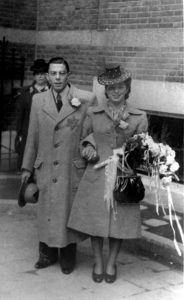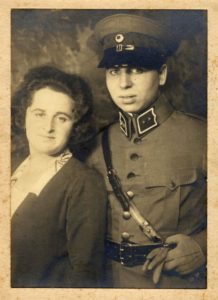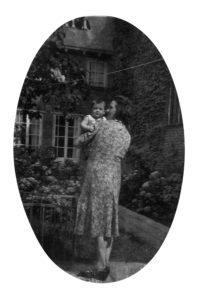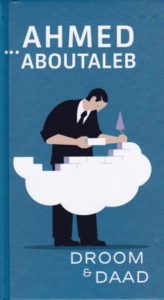An extraordinary discovery was made in 2006 in the Breeplein Church in Rotterdam South (the Netherlands). Diagonally above the imposing organ were hideouts where seven Jewish people had hidden during the Second World War. On the wooden floor there was still evidence of this: food packaging, candy wrapping, matches, some clothes, a tin with small coals, a small broken lamp…
Who were these people and who had helped them to hide? How could they have survived in a cold, dark attic and what drove the protectors to risk their own lives for these families?
Rebecca and Maurice
Increasing numbers of Jews were deported to Germany from occupied Netherlands in 1942. Most of them were murdered in the gas chambers. The seventeen-year-old Rebecca Andriesse and her 25-year-old fiancé Maurice Kool thought that they could stay together if they were married, so they did so as soon as possible. Rebecca’s grandfather arranged for them to go into hiding in the Breeplein Church. The sexton, Jacobus de Mars, created in the attic next to the organ, a hideout which could be accessed by a ladder and an “invisible” trapdoor. Rebecca’s grandfather and many of the family members failed to find a safe hiding place for themselves. They were deported to Germany and never returned.

Meijer and Ida
Meijer and Ida Kool, Maurice’s parents, owned a textile shop on the Beijerlandselaan in Rotterdam. Because they, as Jews, were not allowed to run a business anymore, they also decided to go into hiding. After an unsuccessful attempt elsewhere, they also ended up in the organ attic. During the day the refugees were sometimes downstairs, but for most of the time they were in the attic, where it was very cold in the winter and unbearably hot in the summer.
Chaim and Fifi
Six months after the arrival of Meijer and Ida, two more people were sheltered in the attic on the other side of the organ: the pharmacist Chaim and his wife Fifi de Zoete. Their three daughters were placed in other safe houses. Hadassah, one of the girls, was placed with the Van der Leer family, who attended the Breeplein Church services every Sunday. The Brillenburg Wurth family (Reverend and his wife) ensured that Fifi and Chaim could see their daughter after the service, without Hadassah realising that this was happening. They all hoped there would be a reunion, some day in the future.

Enough to eat and… a baby
Thanks to the Resistance in Rotterdam, there was enough to eat for all the refugees as also for all the people helping and protecting them. Rebecca was pregnant and in the beginning of January 1944 she delivered a son. The Surinamese ophthalmologist Dr. Leo Lashley, de reverend’s wife Gerda Brillenburg Wurth and the nurse Riet Dekkers assisted Rebecca during the childbirth. The baby son was named after his grandfather and the sexton but was generally called Emile. To protect everyone’s safety, the baby spent most of the time in the sexton’s house, where his mother came as often as she could to be with him.

Survived!
Annie, the sexton’s daughter, came with her husband and their seven-month-old baby to live with her parents after the razzia of the 10th and 11th of November 1944, as a front for the young Emile. Should the neighbours hear a baby cry or crown with pleasure, it would be a normal sound; not anything especially remarkable.
There was a raid on the 14th of April 1945, in which the sexton was arrested there was a real threat of the refugees being discovered. ‘Even if they beat him to death, my husband would never betray you’ said the sexton’s wife determinedly; and indeed, he did not. The Netherlands was liberated three weeks later and all of the people in hiding were safe and free… everyone survived the War.
The story of the Organ Attics is one of wonder and lucky coincidences, courage and hope, a story with a happy ending.
Dreams and Deeds
In 2015, inspired by the story of the refugees in the Breeplein Church, the Mayor of Rotterdam, Ahmed Aboutaleb, wrote an essay titled Dreams and Deeds (Droom en Daad in Dutch). He wrote it for “the Month of History”. In it he makes a case for the need for trust and tolerance. He writes: “To nurture trust and tolerance, it is necessary to have perseverance, discipline and heroic courage. As also have tolerance and trust in others. One needs to this because one cannot do it alone.” The essay was published on 1 October 2015 and costs € 7,50. The proceeds go fully towards the establishment of the Organ Attics museum. The book can be bought after completing the guided tours.

Who knows more about the War years?
After the rediscovery of the Organ Attics, the foundation named after them continues to look for more stories and information. What happened and how many other people knew about it? The refugees must have had more helpers than the ones we know about today. More people must have known about this. Do you know more about these war years, do you have related old photographs or artifacts, or do you know someone who would be willing to tell us more about this subject? Please contact us. We would really appreciate your help.
